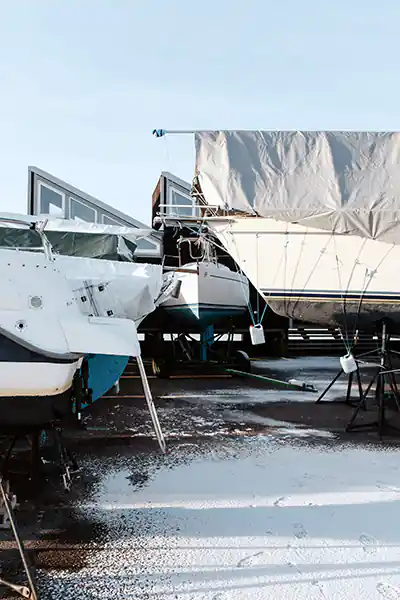5 steps to properly launching your boat after winter storage
The fair sailing season is fast approaching. It’s time to put your boat back in the water. Before you cast off, however, make sure your boat is well prepared for future trips. Let’s take a look at the 5 key steps to successfully launching your boat.
We’ll look at the essential tasks to be carried out in each of the main areas: hull preparation, propulsion, electronics, sails and hardware.
This systematic preparation will enable you to enjoy your boat to the full.
Step 1: Preparing the hull
The first essential stage in successfully restarting your boat after winter storage is to check its general condition after the harsh wintry weather. This means thoroughly reconditioning and preparing the deck and hull before your boat hits the water.

Inspect the entire hull surface carefully and repair any damaged areas. Take care of your hull by cleaning it with acid and soap, and even polishing it for a shiny, spotless finish. Also check the condition of through-hull fittings and valves, including the heads, to make sure everything is in order.
If the antifouling has not yet been done over the winter, then it should be done before you put the boat back in the water. This will prevent the build-up of weed and barnacles, which could slow down your boat and damage its hull. There are also more environmentally-friendly alternatives.
Step 2: Restarting the propulsion system
The second essential step in preparing your boat is to restart your engine(s), including the tender.
Several checks are necessary. Let’s start with the electrical system. Check the condition of the batteries and carry out a visual check of the alternator and starter motor.
Once this is done, you can move on to the cooling system. Check water filters and turbine(s) to make sure they’re in good working order, and replace where necessary.
Next comes the fuel system. Fuel filters and pre-filters need to be checked or replaced to ensure that your engine doesn’t choke on fuel.
Let’s move on to the lubrication system. If it hasn’t been done when storing your boat, change the oil and oil filter(s) to ensure proper engine lubrication.

Don’t forget that it’s also important to replace all sacrificial anodes. This includes exchanger, base, shaft and propeller anodes, and thruster anodes if your boat is fitted with one. These parts protect your engine and propeller from corrosion, so don’t neglect them! Finally, check your propellers and rudder for damage, deformation and excessive looseness.
For greater ease and efficiency, don’t forget that you can also use Ready4Sea’s de-wintering checklist, freely available in the app.
Step 3: Caring for electronic equipment
Checking the electronic equipment is also an essential step in getting the spring back on track. Since it often costs a lot of money, give it some love to ensure it lasts!
Start by thoroughly checking the operation of each piece of electronic equipment. The depth sounder and speedometer should be reinstalled if they have been removed for winter storage. Make sure you also check all connections and cables to avoid any corrosion that could cause connection problems. Once you splash, also plan on re-calibrating your autopilot compass.
If any of your electronic equipment is damaged, don’t hesitate to replace it immediately to avoid breakdowns at sea. Finally, for safe navigation, remember to update your electronic cartography if necessary. If you have removed your chartplotter’s removable card, don’t forget to put it back in.
Step 4: Repairing sails and fittings
This fourth stage is crucial for sailboats, to ensure that your boat is ready to set sail.
Start by checking your sails and lines. Take the time to make sure they’re in good condition. As a general rule, the better you care for your sails, the longer they last. If they haven’t been stored dry and clean, they may be mildewed. In this case, they need to be well cleaned. The sails will then be ready to be set again. But don’t hoist them until you’re afloat, for fear of tipping your boat on the dry.
Also remember to clean and lubricate all fittings to ensure smooth operation and prevent corrosion. Furling systems, winches and windlasses are particularly important, but so are blocks, winches and clutches.
Remember to check the rigging thoroughly, inspecting all components such as forestay, shrouds, spreaders and blocks. Signs of wear or structural weakness may appear on fittings and crimpings.
Finally, be sure to clean and check the condition of your ground tackle, including inspecting the chain markings. If you have a chain counter, check that its sensor is working properly and calibrated.

Step 5: Launch and final checks
It’s finally time to cast off. But before you do, a few final checks are in order.
Don’t forget to install all the necessary safety equipment, whether for a coastal trip or an offshore passage. The Ready4Sea app has a checklist for this too.
Also make sure that mooring lines and fenders are in place to prevent damage to the boat when it’s launched again.
Once afloat, take the opportunity to check the boat’s lateral and longitudinal stability. If it doesn’t feel right, check that the weight on board is evenly distributed. And why not take the opportunity to unload anything superfluous on board?
Before setting off on your first real navigation, carry out a shakedown outing to make sure all the equipment is working properly. This will enable you to identify any problems before venturing out to sea.
Congratulations, you’re now ready to sail!

Have a great season!
Wrapping up
The best way to sail all season long with a safe and reliable boat is to prepare it carefully right from the start.
By following these five steps, you’ll be able to fully relax and enjoy your boating adventures. Now you’re ready for some memorable sailing days. Fair winds and following seas!
